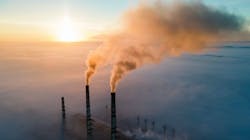IEA: Global CO2 Emissions continue to rise despite C&I Decarbonization efforts
The commercial and industrial energy transition is making inroads into decarbonization, although it isn’t yet enough to offset emissions growth from a rebound in coal-fired power, according to the annual report from the International Energy Agency.
IEA’s latest take on “CO2 Emissions in 2022” indicated that greenhouse gas emissions by the industrial sector actually fell by 1.7 percent, or 9.2 gigatons, last year. Some of this was due to a decline in Chinese cement production, but also benefit from increased efforts in renewable energy installments, energy efficiency projects within factories and electrification of heating for buildings, among other things.
Altogether, global energy-releated carbon dioxide emissions increased by only 0.9 percent around the world, a much smaller rise than the alarming 6 percent in 2021 as economies benefitted growth due to post-pandemic recoveries.
That’s not to say that the slower increase is good news for the environment. Industrial process emissions did decline a substantial 102 metric tons, but the global all-sectors total still rose by 321 metric tons (MT) to a new all-time high of 36.8 gigatons of CO2 into the atmosphere.
“The impacts of the energy crisis didn’t result in the major increase in global emissions that was initally feared—and this is thanks to the oustanding growth of renewables, electric vehicles, heat pumps and energy-efficient technologies,” IEA Executive Director Fatih Birol said. “Without clean energy, the growth in CO2 emissions would have been nearly three times as high. However, we still see emissions growing from fossil fuels, hindering efforts to meet the world’s climate targets.”
U.S. emissions grew by 0.8 percent or 36 MT. Extreme temperatures such as droughts and winter storms drove higher energy use by the buildings sector. Gas-fired power generation also increased emissions by 89 MT because of peak electricity use during summer heat waves, according to the IEA.
Developing and fast-growing economies such as China and India are continuing to permit coal-fired power plants as they strive to provide electricity to as many of their populations as possible—the same approach that nations such as the United States took a century earlier.
Indeed, emissions from non-China Asia and other emerging markets increased by 4.2 percent of 206 metric tons of CO2. More than half of that rise originated from coal-fired power generation. China's emissions dropped slightly.
The European Union also saw a 2.5 percent, or 70 MT, reduction.
About the Author
EnergyTech Staff
Rod Walton is senior editor for EnergyTech.com. He has spent 17 years covering the energy industry as a newspaper and trade journalist.
Walton formerly was energy writer and business editor at the Tulsa World. Later, he spent six years covering the electricity power sector for Pennwell and Clarion Events. He joined Endeavor and EnergyTech in November 2021.
He can be reached at [email protected].
EnergyTech is focused on the mission critical and large-scale energy users and their sustainability and resiliency goals. These include the commercial and industrial sectors, as well as the military, universities, data centers and microgrids.
Many large-scale energy users such as Fortune 500 companies, and mission-critical users such as military bases, universities, healthcare facilities, public safety and data centers, shifting their energy priorities to reach net-zero carbon goals within the coming decades. These include plans for renewable energy power purchase agreements, but also on-site resiliency projects such as microgrids, combined heat and power, rooftop solar, energy storage, digitalization and building efficiency upgrades.
